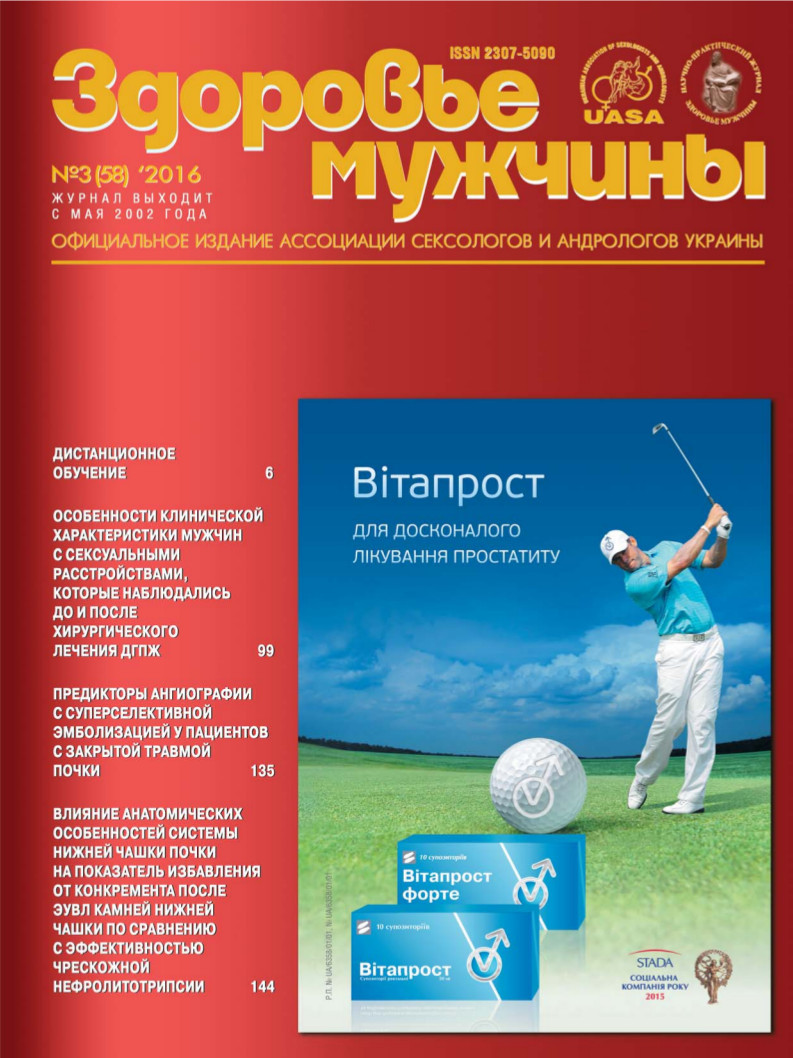Predictors of angiographic superselective embolization in patients with blunt renal injury
##plugins.themes.bootstrap3.article.main##
Abstract
The aim of the study: to determine the effectiveness of angiography with renal artery embolization in patients with blunt renal injury (BRI) by the definition of predictors of complications.
Materials and methods. The article presents the results of treatment of 301 patients with isolated BRI, which were divided into two groups: basic (n=171) and control (n=130). The main group consisted of patients with BRI, who were treated from 2004 to 2014, the effectiveness of the treatment which were analyzed prospectively. This group also included 21 patients who underwent angiography with renal artery embolization (RAE). The control group included patients treated from 1989 to 2003, the effectiveness of the treatment which were analyzed retrospectively. Patients of the main group used "the most conservative approach, which included conservative treatment (CT) of hemodynamically stable patients with I–IV degree of severity of the injury. Absolute indications to surgical treatment of patients prospective group was V degree injury to the kidneys and unstable hemodynamics, which is not corrected with conservative methods of treatment.
Results. By mathematical analysis using the statistical package Statiatical Package for the Social Science (SPSS) version 17 was used to determine the value of RAE in patients with BRI. The results of a comparative study show that the predictors RAE with 95% confidence are: hemoglobin level during hospitalization, retroperitoneal hematoma, transfusion intermediaries. In 36 patients of the control group, who were performed surgical treatment, at 36.1% could be RAE.
##plugins.themes.bootstrap3.article.details##

This work is licensed under a Creative Commons Attribution 4.0 International License.
Authors retain the copyright and grant the journal the first publication of original scientific articles under the Creative Commons Attribution 4.0 International License, which allows others to distribute work with acknowledgment of authorship and first publication in this journal.
References
Broghammer JA, Fisher MB, Santucci RA. Conservative management of renal trauma: a review. Urology. 2007 Oct. 70(4):623–9.
Chiron P, Hornez E, Boddaert G, Dusaud M, Bayoud Y, Molimard B, et al. Grade IV renal trauma management. A revision of the AAST renal injury grading scale is mandatory. Eur J Trauma Emerg Surg. 2015 May 19.
Fraser JD, Aguayo P, Ostlie DJ, St Peter SD. Review of the evidence on the management of blunt renal trauma in pediatric patients. Pediatr Surg Int. 2009 Feb. 25 (2):125–32.
Grimsby GM, Voelzke B, Hotaling J, Sorensen MD, Koyle M, Jacobs MA. Demographics of pediatric renal trauma. J Urol. 2014 Nov. 192(5):1498-502.
Lee JN, Lim JK, Woo MJ, Kwon SY, Kim BS, Kim HT, et al. Predictive factors for conservative treatment failure in grade IV pediatric blunt renal trauma. J Pediatr Urol. 2015 Aug 5.
Morey AF, Brandes S, Dugi DD 3rd, Armstrong JH, Breyer BN, Broghammer JA, et al. Urotrauma: AUA guideline. J Urol. 2014 Aug. 192(2): 327–35.
Wang HL, Xu CY, Wang HH, Xu W. Emergency Transcatheter Arterial Embolization for Acute Renal Hemorrhage. Medicine (Baltimore). 2015 Oct. 94 (42): e1667.





